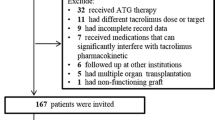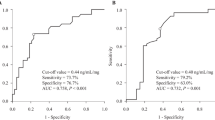Abstract
Purpose
We assessed reported associations of CYP3A5 *1 allele with a delay in achieving target tacrolimus concentrations, and occurrence of biopsy-confirmed subclinical acute rejection (SAR) and chronic allograft nephropathy (CAN) in Japanese subjects.
Methods
Forty-one renal allograft recipients were studied. The targeted tacrolimus trough concentrations were 20–25 ng/mL up to 2 weeks post-transplantation, 10–15 ng/mL up to 6 weeks, and 5–10 ng/mL thereafter. At 1 month and 1 year post-transplantation, allograft biopsies were performed.
Results
The CYP3A5 *1/*1 + *1/*3 (expresser) and *3/*3 (nonexpresser) alleles were detected in 19 and 22 patients, respectively. Although the mean trough concentrations were lower in CYP3A5 expressers than nonexpressers for the first 3 weeks, no difference in frequency of SAR among CYP3A5 genotypes was found. The mean trough concentrations were lower from 8 to 12 months post-transplantation, and the frequency of CAN was lower in CYP3A5 expressers.
Conclusions
In contrast to the previous reports, the CYP3A5 *1 allele was not associated with the frequency of SAR or CAN, suggesting that further studies of different immunosuppressive strategies using tacrolimus are needed to confirm the adequate dosing and concentration of tacrolimus for each CYP3A5 genotype.


Similar content being viewed by others
References
Venkataramanan R, Swaminathan A, Prasad T, Jain A, Zuckerman S, Warty V, McMichael J, Lever J, Burckart G, Starzl T (1995) Clinical pharmacokinetics of tacrolimus. Clin Pharmacokinet 29:404–430
Haufroid V, Wallenmacq P, VanKerckhove V, Elens L, De Meyer M, Eddour DC, Malaise J, Lison D, Mourad M (2006) CYP3A5 and ABCB1 polymorphisms and tacrolimus pharmacokinetics in renal transplant candidates: guidelines from an experimental study. Am J Transplant 6:2706–2713
Hessenlink DA, van Schaik RH, van der Heiden IP, van der Werf M, Gregoor PJ, Lindemans J, Weimar W, van Gelder T (2003) Genetic polymorphisms of the CYP3A4, CYP3A5, and MDR-1 genes and pharmacokinetics of the calcineurin inhibitors cyclosporine and tacrolimus. Clin Pharmacol Ther 74:245–254
Haufroid V, Mourad M, Van Kerckhove V, Wawrzyniak J, De Meyer M, Eddour DC, Malaise J, Lison D, Squifflet JP, Wallemacq P (2004) The effect of CYP3A5 and MDR1 (ABCB1) polymorphisms on cyclosporine and tacrolimus dose requirements and trough blood levels in stable renal transplant recipients. Pharmacogenetics 14:147–154
Tsuchiya N, Satoh S, Tada H, Li Z, Ohyama C, Sato K, Suzuki T, Habuchi T, Kato T (2004) Influence of CYP3A5 and MDR1 (ABCB1) polymorphisms on the pharmacokinetics of tacrolimus in renal transplant recipients. Transplantation 78:1182–1187
Tada H, Tsuchiya N, Satoh S, Kagaya H, Li Z, Sato K, Miura M, Suzuki T, Kato T, Habuchi T (2005) Impact of CYP3A5 and MDR1 (ABCB1) C3435T polymorphisms on the pharmacokinetics of tacrolimus in renal transplant recipients. Transplant Proc 37:1730–1732
Roy JN, Barama A, Poirier C, Vinet B, Roger M (2006) Cyp3A4, Cyp3A5, and MDR-1 genetic influences on tacrolimus pharmacokinetics in renal transplant recipients. Pharmacogenet Genomics 16:659–665
MacPhee IA, Fredericks S, Tai T, Syrris P, Carter ND, Johnston A, Goldberg L, Holt DW (2004) The influence of pharmacogenetics on the time to achieve target tacrolimus concentrations after kidney transplantation. Am J Transplant 4:914–919
Kuypers DR, de Jonge H, Naesens M, Lerut E, Verbeke K, Vanrenterghem Y (2007) CYP3A5 and CYP3A4 but not MDR1 single-nucleotide polymorphisms determine long-term tacrolimus disposition and drug-related nephrotoxicity in renal recipients. Clin Pharmacol Ther 82:711–725
Undre NA, van Hooff J, Christiaans M, Vanrenterghem Y, Donck J, Heeman U, Kohnle M, Zanker B, Land W, Morales JM, Andres A, Schafer A, Stevenson P (1999) Low systemic exposure to tacrolimus correlates with acute rejection. Transplant Proc 31:296–298
Staatz C, Taylor P, Tett S (2001) Low tacrolimus concentrations and increased risk of early acute rejection in adult renal transplantation. Nephrol Dial Transplant 16:1905–1909
Tada H, Satoh S, Iinuma M, Shimoda N, Murakami M, Hayase Y, Kato T, Suzuki T (2003) Chronopharmacokinetics of tacrolimus in kidney transplant recipients: occurrence of acute rejection. J Clin Pharmacol 43:859–865
Inoue K, Miura M, Satoh S, Kagara H, Saito M, Habuchi T, Suzuki T (2007) Influence of UGT1A7 and UGT1A9 intronic I1399 genetic polymorphisms on mycophenolic acid pharmacokinetics in Japanese renal transplant recipients. Ther Drug Monit 29:299–304
Racusen LC, Solez K, Colvin RB, Bonsib SM, Castro MC, Cavallo T et al (1999) The Banff 97 working classification of renal allograft pathology. Kidney Int 55:713–723
Solez K, Colvin RB, Racusen LC, Sis B, Halloran PF, Birk PE et al (2007) Banff ’05 meeting report; differential diagnosis of chronic allograft injury and elimination of chronic allograft nephropathy (CAN). Am J Transplant 7:518–526
Numakura K, Satoh S, Tsuchiya N, Horikawa Y, Inoue T, Kakinuma H, Matsuura S, Saito M, Tada H, Suzuki T, Habuchi T (2005) Clinical and genetic risk factors for posttransplant diabetes mellitus in adult renal transplant recipients treated with tacrolimus. Transplantation 80:1419–1424
Vincenti F, Laskow DA, Neylan JF, Mendez R, Matas AJ (1996) One-year follow up of an open-label trial of FK506 for primary kidney transplantation. A report of the U.S. Multicenter FK506 Kidney Transplant Group. Transplantation 61:1576–1581
Japanese FK506 Study Group (1992) Japanese study of kidney transplantation. 1. Results of early phase II study. Transplant Int 5(Suppl 1):S524–S528
Spencer CM, Goa KL, Gillis JC (1997) Tacrolimus. An update of its pharmacology and clinical efficacy in the management of organ transplantation. Drugs 54:925–975
Gruber SA, Hewitt JM, Sorenson AL, Barber DL, Bowers L, Rynders G, Arrazola L, Matas AJ, Rosenberg ME, Canafax DM (1994) Pharmacokinetics of FK506 after intravenous and oral administration in patients awaiting renal transplantation. J Clin Pharmacol 34:859–864
Jain AB, Abu-Elmagd K, Abdallah H, Warty V, Fung J, Todo S, Starzl TE, Venkataramanan R (1993) Pharmacokinetics of FK506 in liver transplant recipients after continuous intravenous infusion. J Clin Pharmacol 33:606–611
Satoh S, Tada H, Tachiki Y, Tcuchiya N, Shimoda N, Akao T, Sato K, Habuchi T, Suzuki T, Kato T (2001) Chrono and clinical pharmacokinetic study of tacrolimus in continuous intravenous administration. Int J Urol 8:353–358
Miller J, Mendez R, Pirsch JD, Jensik SC (2000) Safety and efficacy of tacrolimus in combination with mycophenolate mofetil (MMF) in cadaveric renal transplant recipients. FK506/MMF dose-ranging kidney transplant study group. Transplantation 69:875–880
Ortiz F, Paavonen T, Tornroth T, Koskinen P, Finne P, Salmela K, Kyllonen L, Gronhagen-Riska C, Honkanen E (2005) Predictors of renal allograft histologic damage progression. J Am Soc Nephrol 16:817–824
Bakker RC, Hollander AA, Mallat MJ, Bruijin JA, Paul LC, de Fijter JW (2003) Conversion from cyclosporine to azathioprine at three months reduces the incidence of chronic allograft nephropathy. Kidney Int 64:1027–1034
Lamba JK, Lin YS, Schuetz EG, Thummel KE (2002) Genetic contribution to variable human CYP3A-mediated metabolism. Adv Drug Delivery Rev 54:1271–1294
Acknowledgements
This study was partially supported by a grant (No. 20591894) from the Japanese Society for the Promotion of Science, and published at the 2008 American Transplant Congress in Toronto.
Author information
Authors and Affiliations
Corresponding author
Rights and permissions
About this article
Cite this article
Satoh, S., Saito, M., Inoue, T. et al. CYP3A5 *1 allele associated with tacrolimus trough concentrations but not subclinical acute rejection or chronic allograft nephropathy in Japanese renal transplant recipients. Eur J Clin Pharmacol 65, 473–481 (2009). https://doi.org/10.1007/s00228-008-0606-3
Received:
Accepted:
Published:
Issue Date:
DOI: https://doi.org/10.1007/s00228-008-0606-3




